Warning: pic heavy, as usual. 
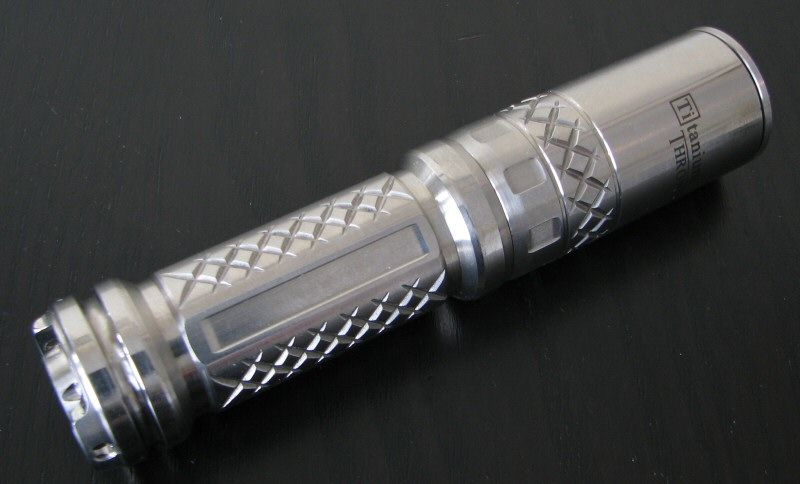
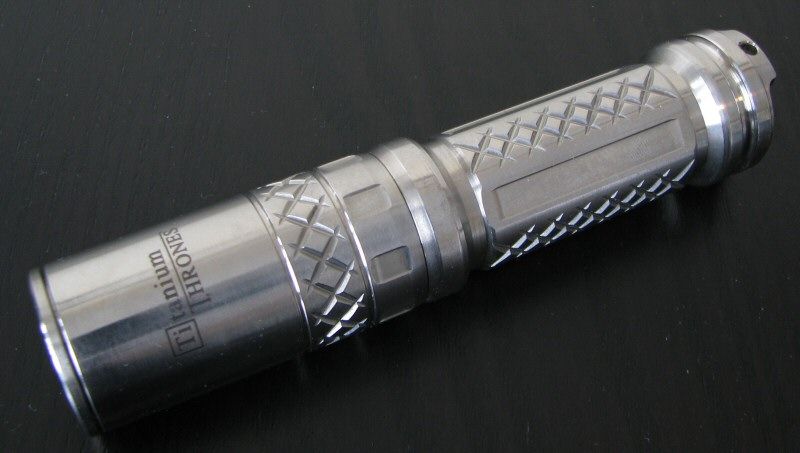
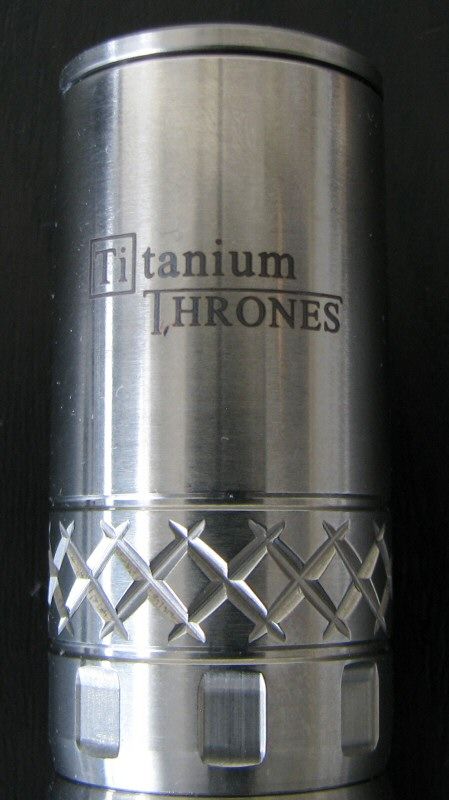
Sunwayman has released a titanium 1x18650 model, the C25C-Ti "Thrones". Judging from the font (and the imagery on their promotional material), I don't think it would be going out on limb to suggest that they are trying to link this to the popular Game of Thrones TV series and novels.
You don't see all-titanium lights in the 1x18650 class very often (likely due to the significant amount of titanium required). I think the last one I reviewed was the Bronte TU10-Ti.
The C25C Ti has some distinctive build elements … let's see how it compares to other lights in the 1x18650 class. :wave:
Manufacturer Reported Specifications:
(note: as always, these are simply what the manufacturer provides – scroll down to see my actual testing results).
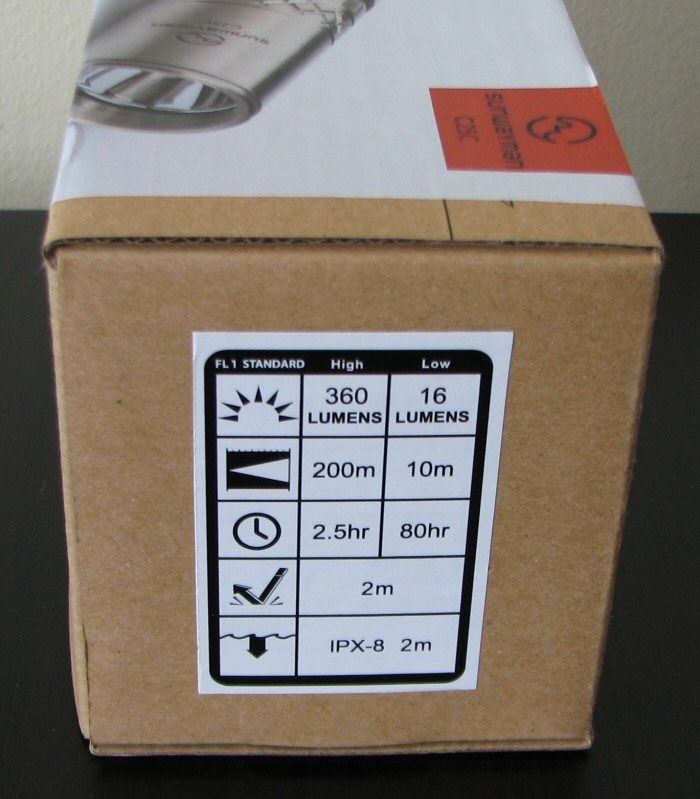
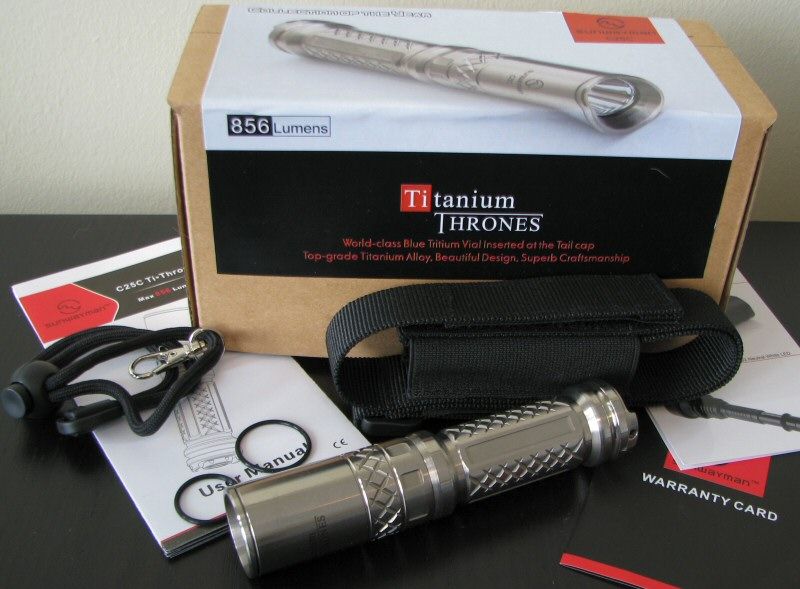
Packaging is a hard cardboard box with packing foam. As always, detailed specs and information are printed right on the box. Inside, included with the light are spare O-rings, wrist lanyard, holster with Velcro closing flap, product inserts, warranty card, and manual.
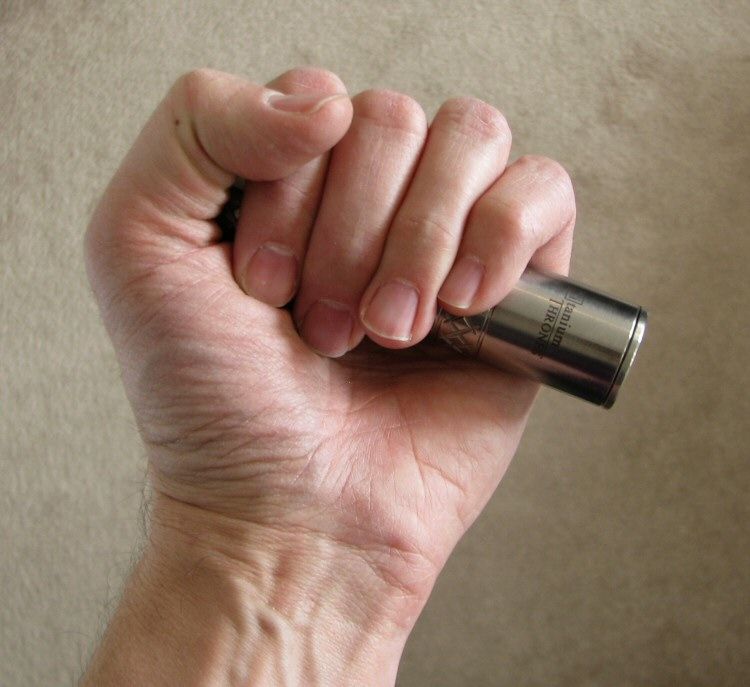
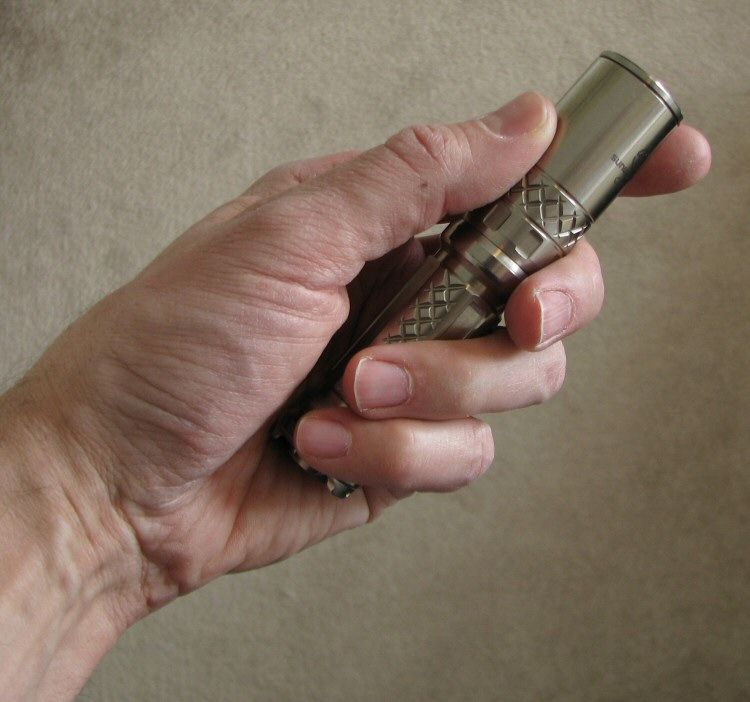
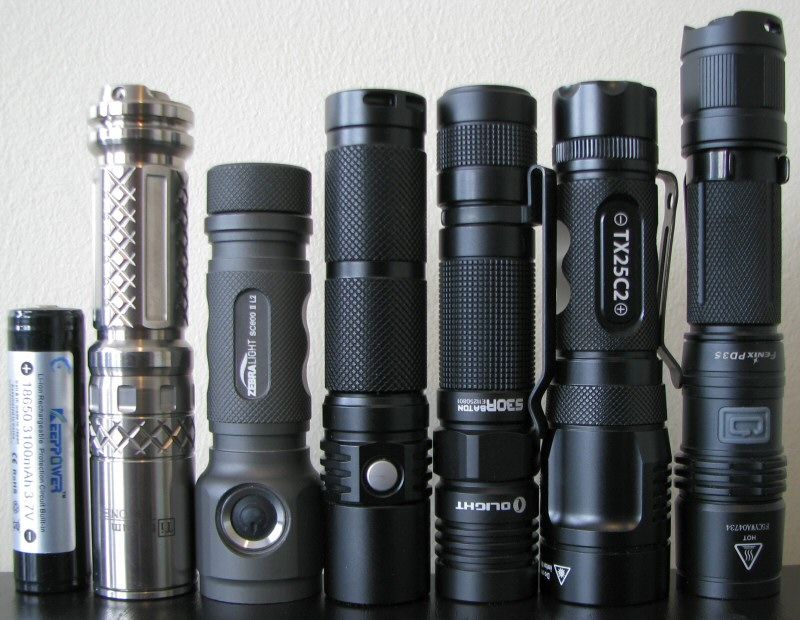 From left to right: Keeppower Protected 3100mAh 18650; Sunwayman C25C Ti; Zebralight SC600-II; Thrunite Neutron 2C 2014; Olight S30R; Eagletac TX25C2; Fenix PD35.
From left to right: Keeppower Protected 3100mAh 18650; Sunwayman C25C Ti; Zebralight SC600-II; Thrunite Neutron 2C 2014; Olight S30R; Eagletac TX25C2; Fenix PD35.
All dimensions directly measured, and given with no batteries installed:
Sunwayman C25C Ti Weight: 92.9g, Length: 120.2mm, Width (bezel): 25.3mm
Bronte TU10-Ti: Weight: 135.8g, Length: 140.6mm, Width (bezel): 30.6mm (32.2mm at widest base)
Eagletac D25LC2: Weight: 50.0g, Length: 116.3mm, Width (bezel): 22.5mm
Eagletac TX25C2: Weight 93.6g, Length: 120.4mm, Width (bezel): 31.6mm
Fenix PD35: Weight: 82.7g, Length: 138.1mm, Width (bezel): 25.4mm
Nitecore P12 2015: Weight: 88.7g, Length: 139.5mm, Width (bezel): 25.5mm
Nitecore P10: Weight 82.0g, Length: 135.1mm, Width (bezel): 25.5mm
Nitecore EC20: Weight: 77.1g, Length: 129.2mm, Width (bezel): 25.4mm
Thrunite TN12-2014: Weight: 80.0g, Length: 140.5mm, Width (bezel): 25.4mm
Skilhunt DS20: Weight: 53.8g, Length: 110.0mm, Width (bezel): 24.0mm
Zebralight SC600 II: Weight 79.3g, Length: 101.8mm, Width (bezel) 29.7mm
As you would expect for a titanium light, the C25C-Ti is heavier than most of the competition – but is still quite reasonable for the class.
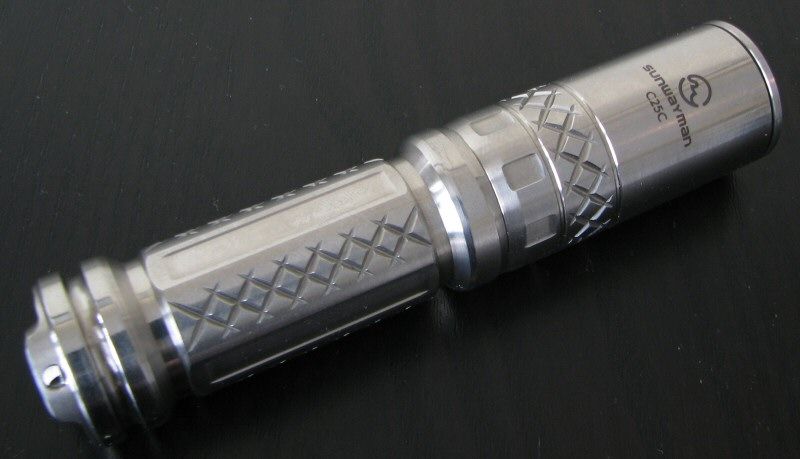
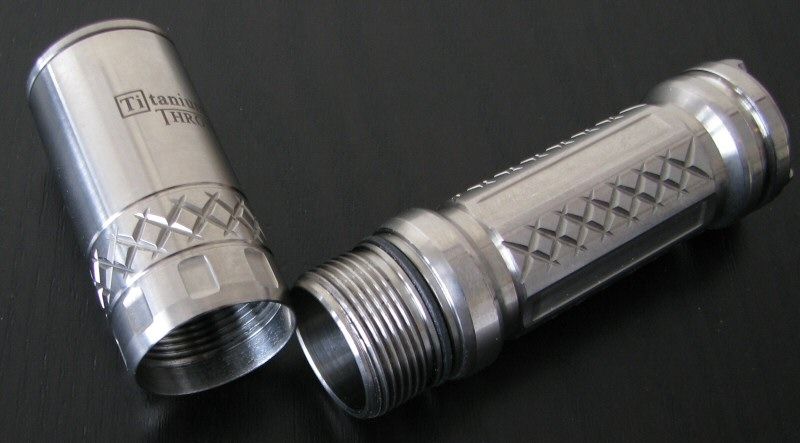
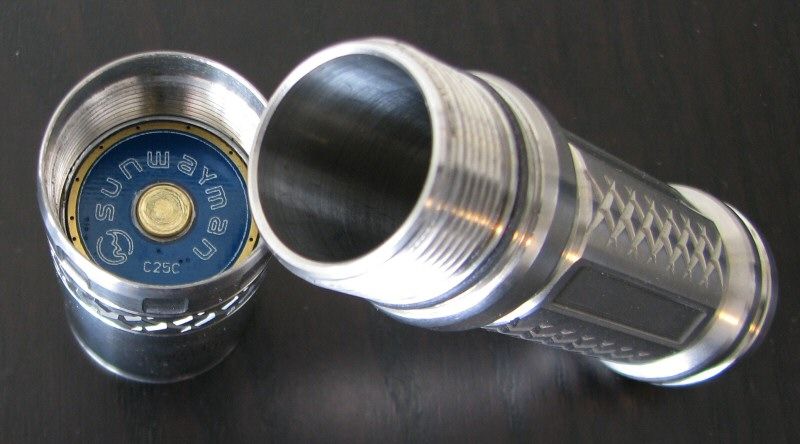
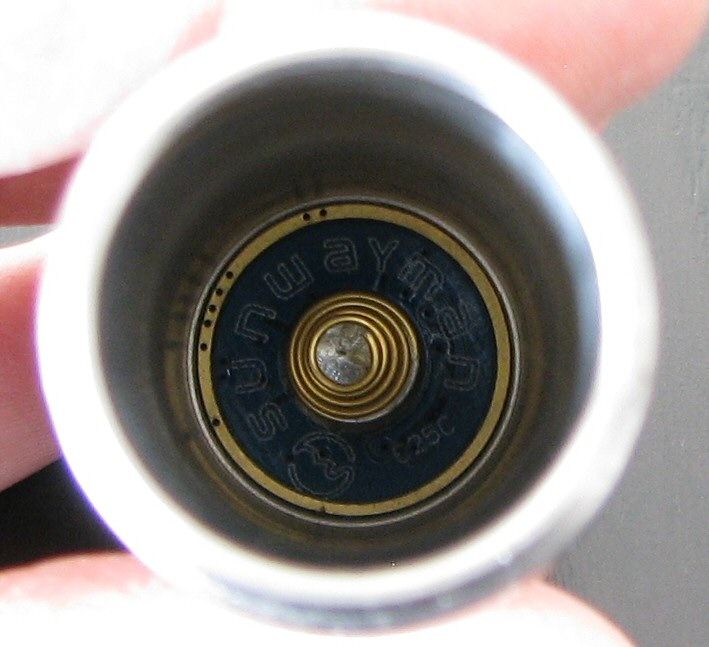
The C25C-Ti is a distinctive light. oo: Featuring CNC-machined titanium alloy, this "throne" has a distinctive look and feel.
oo: Featuring CNC-machined titanium alloy, this "throne" has a distinctive look and feel. 
Weight has obviously increased over a comparably sized aluminum light, and the C25C-Ti has a substantial feel. There is good ridge detail all along the body and base of the head – nice and deep. This is something that is often limited on titanium lights. As a result, I would say overall grip is reasonable in this case (i.e., better than I was expecting, but not as high some lights). Unfortunately, the light can roll easily.
As always, I find fingerprints show up easily on the shiny titanium finish (but are easily wiped off). Labels are laser engraved, and fairly subtle and elegant.
There is a slightly raised contact point on the positive contact board in the head, so flat-top cells work fine. There is a spring at the base of the light.
The light uses standard triangular cut screw threads (and a good number of them). There is some galling on my sample (common to titanium lights), but it seems better here than on smaller titanium lights I've handled. There is no physical lock-out available – the light makes contact with the battery within the first turn of the threads.
The tail region is where things get interesting:
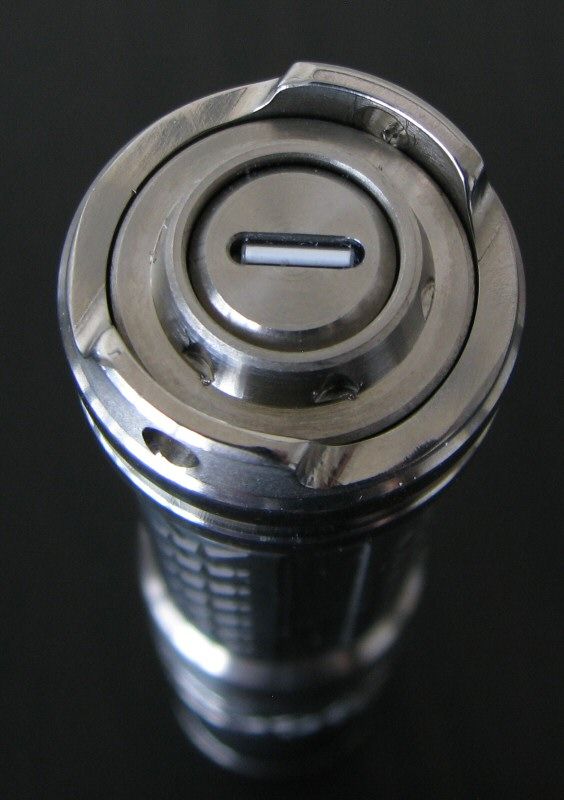
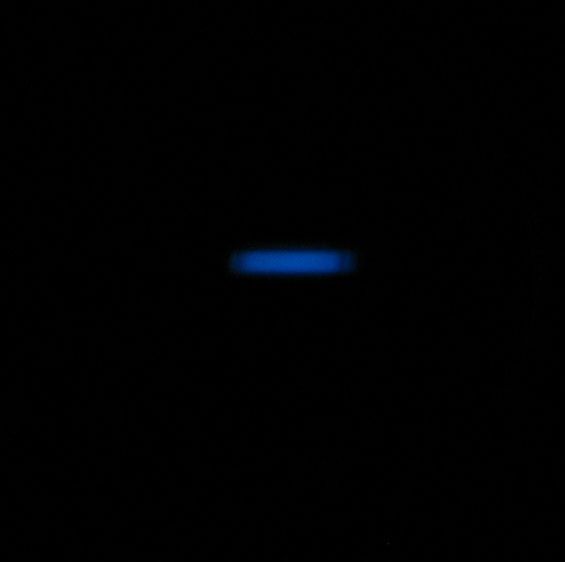
Unusually, the light uses an electronic switch in the tail. Not sure why they went with an electronic switch, but I have noticed that physical clickies with metal switch covers (especially on titantium lights), can be problematic for smooth and consistent operation. The switch here is recessed within a surrounding area, and has a very short traverse (consistent with electronic switches). There is a subtle click when fully pressing it. There are raised guards along the outside of the tail, where you can attach a wrist lanyard. The light can tailstand stably.
What really interesting here is the addition of the blue trit. While popular with a number of the custom makers/modders, this is the first time I can recall seeing one on a mainstream light from a major manufacturer. oo: Trits are small glass vials that contain a radioactive isotope of hydrogen – tritium – which is a weak beta emitter (don't worry, it's quite safe). The emitted electrons interact with a phosphor coating inside the vial producing fluorescent light (blue in this case), through the phenomenon of radioluminescence.
oo: Trits are small glass vials that contain a radioactive isotope of hydrogen – tritium – which is a weak beta emitter (don't worry, it's quite safe). The emitted electrons interact with a phosphor coating inside the vial producing fluorescent light (blue in this case), through the phenomenon of radioluminescence.
As this sort of illumination requires no electrical energy, you will commonly find it in high-end wrist watches and emergency exit signs. And unlike the more common glow-in-the-dark phosphors you'll see on cheap watches (and o-rings, boot switch covers, etc), you don't need to pre-charge with visible light first – the tritium is a regular source of electrons (well, for a while anyway – its half-life is a little over a decade).
As with most trits, the fluorescent light emitted isn't very bright – but it doesn't need to be. For dark-adapted eyes, it's a very comfortable level of light to help you find the switch in the dark. :thumbsup:
Another interesting feature is the battery read-out indicator upon activation, which is a red light around the switch button.
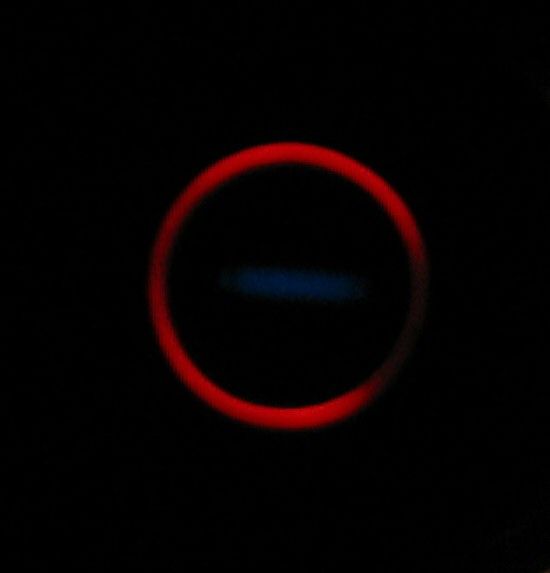
For the shot above, I turned the light on while head-standing the flashlight in the dark. As you can see, the indicator glows red when you first activate the light (you can faintly see the blue trit in the middle of the pic above). With a fully charged cell, the red indicator flashed 3 times. According to the instructions online, it will flash once when voltage is between ~3V-3.4V, twice when ~3.5-4V, and three times when ~4V-4.2V. Oddly, it is supposed to flash five times when below 3V.
Let's look at the head:
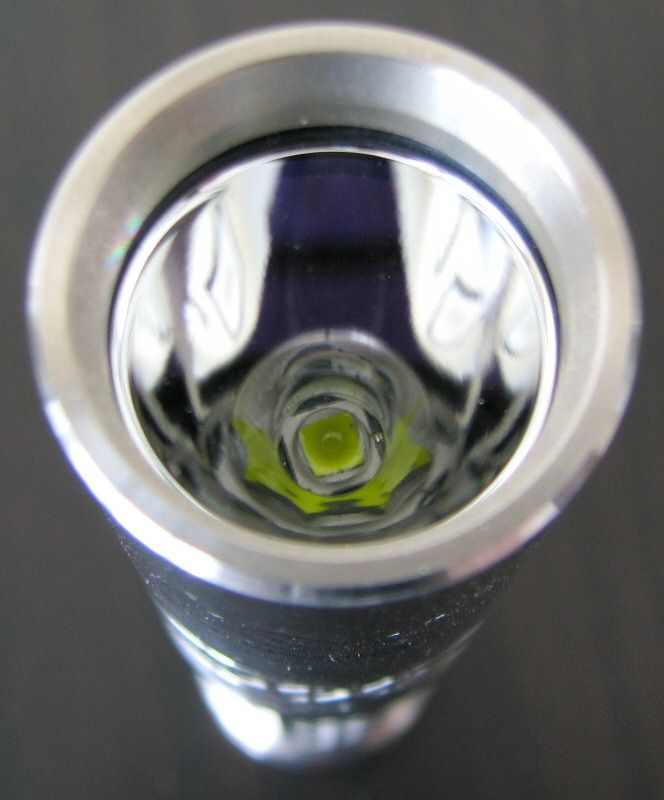
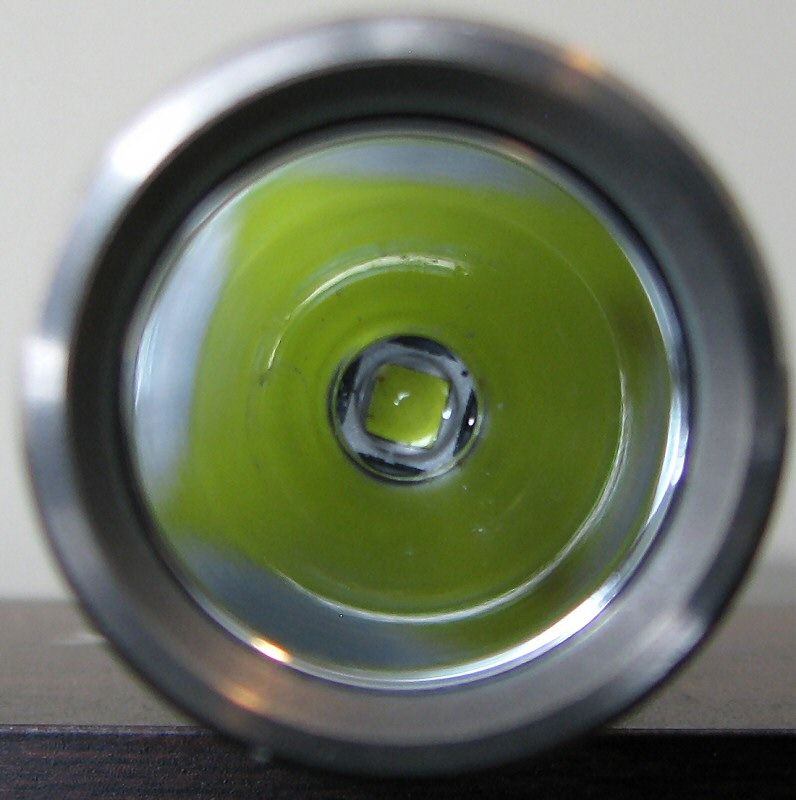
The C25C-Ti comes with a flat titanium bezel. Reflector is smooth, and surprisingly deep given this size head. Coupled with the XM-L2 cool white emitter (which was well centered on my sample), I would expect a fairly narrow spillbeam, with above average throw for a light this size. Scroll down for beamshots.
User Interface
The user interface is straight-forward. Turn the light on/off by a press-hold of the switch (>1 sec)
Change modes my clicking the switch (rapid press-release). Mode sequence is Lo > Med > Hi > Turbo, in repeating sequence. The light has mode memory, and retains the last level set if you turn off/on.
There a "hidden" strobe mode, accessed by a double-click of the switch when on. A single click returns you to the memorized constant-on mode.
There is a lockout mode from off – double click the switch, but hold on the second click (i.e. a rapid click and press hold). This will prevent accidental activation. Repeat the sequence to unlock the light.
Video:
For more information on the overall build and user interface, please see my video overview:
As with all my videos, I recommend you have annotations turned on. I commonly update the commentary with additional information or clarifications before publicly releasing the video.
As an aside, if you want to get an instant notification for every new review that I post here on CPF, you can subscribe to my YouTube channel (the vids go public at the same time). Just mouse over my logo watermark on the top right-hand corner of the video for the subscribe feature to open up. You may need to tap or click, depending on the platform you are using to watch. :wave:
PWM/Strobe
The C25C-Ti uses pulse width modulation (PWM) at all levels.
Lo:
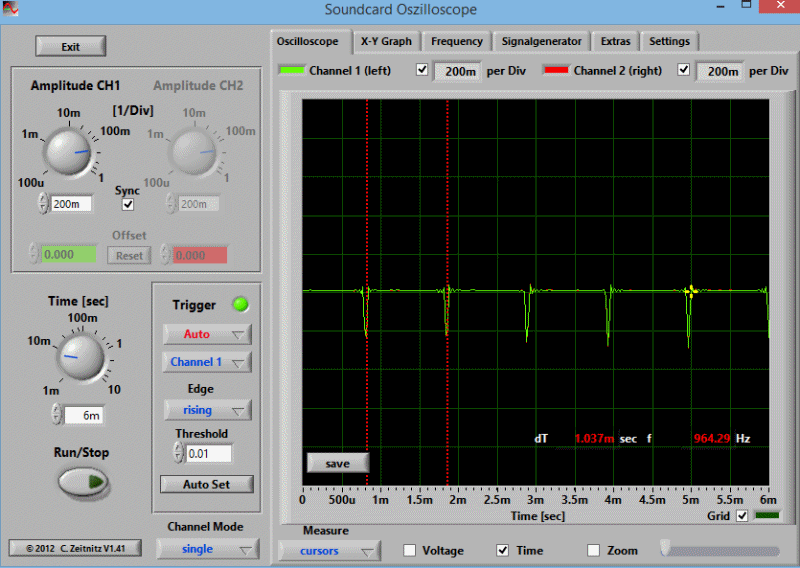
Med:
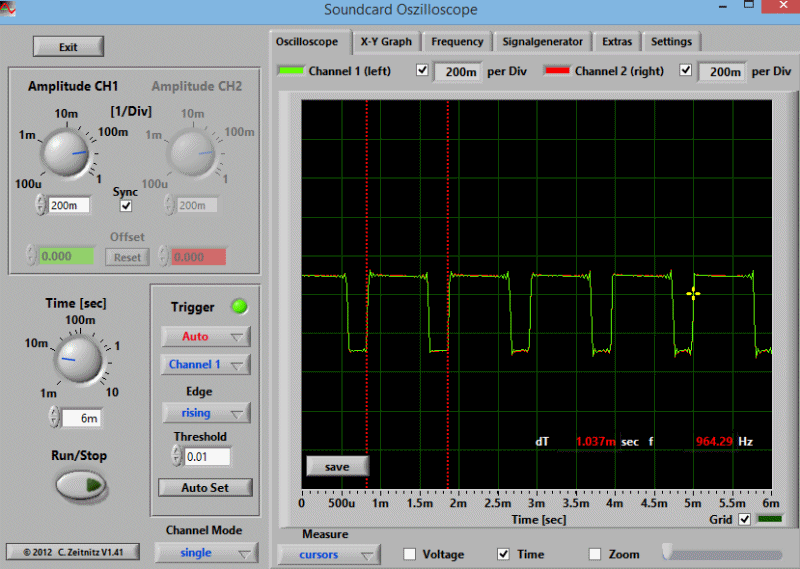
Hi:
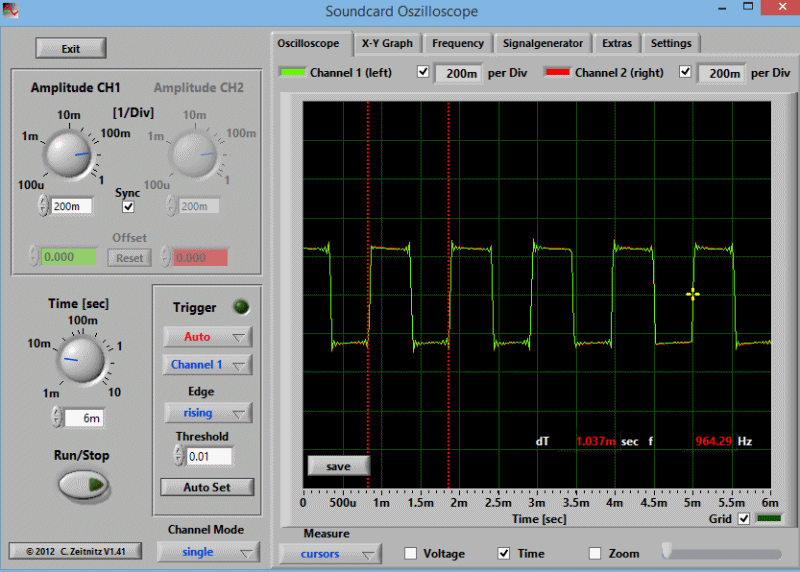
Turbo:
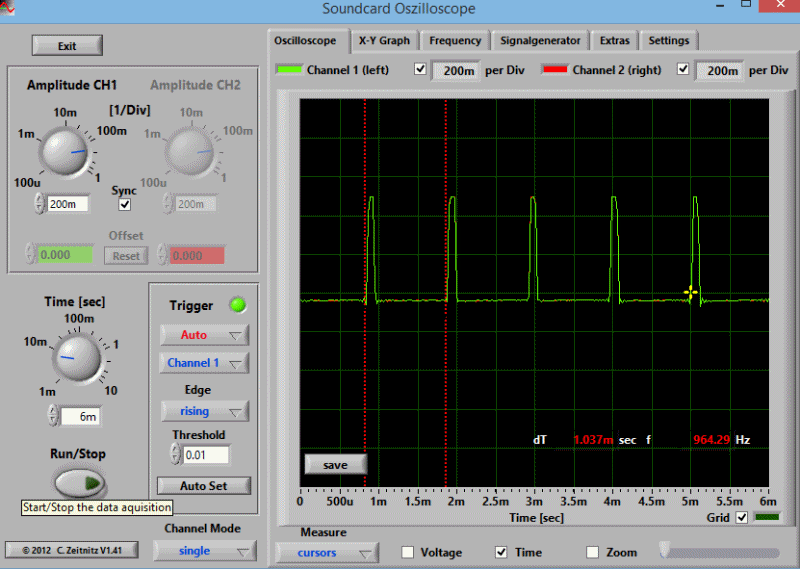
This is a classic PWM pattern, with an increasing pulse duration as you go up in output level, all with a common 964 Hz frequency. What is a little unusual is its continued presence on Turbo. I suspect this latter point reflects how the electronic tail switch interacts with the circuit in the head (and how it responds to different battery voltages). See runtimes later in this review for additional commentary.
In any case, I find this 964 Hz frequency noticeable in use, especially at the lower levels. You will want to keep this in mind if you are particularly sensitive to PWM flicker.
There is also a secondary signal noise pattern, noticeable at longer time scales on my oscilloscope. Here is an example on the Lo level:
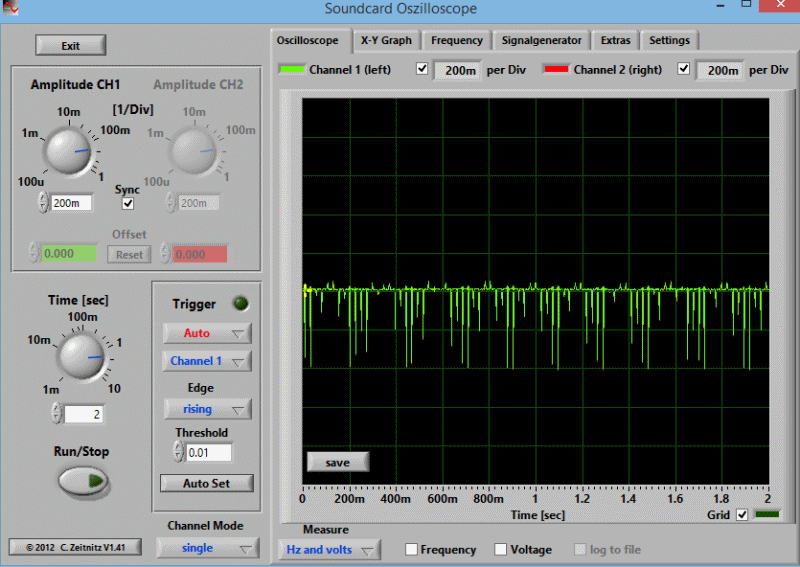
This doesn't produce any visible effect, however.
Strobe
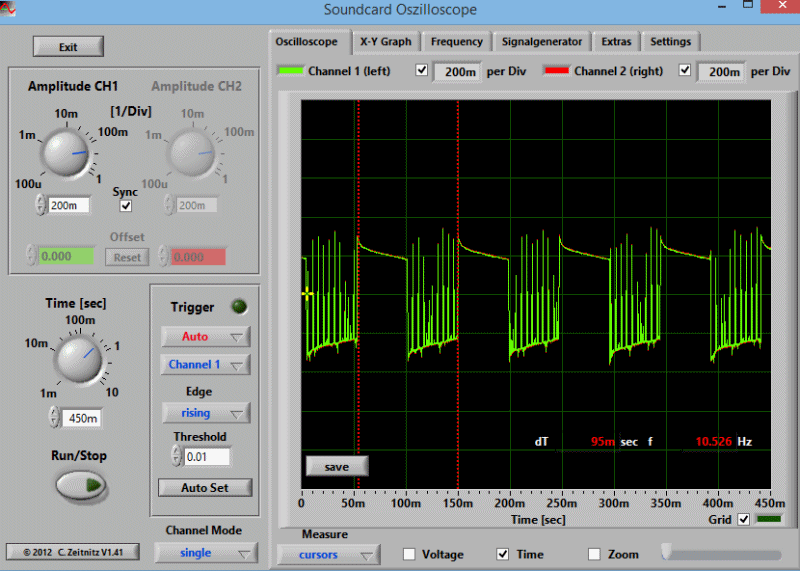
The strobe is a fast "tactical" strobe, at 10.5 Hz frequency. You can see the effect of the secondary circuit noise in the oscilloscope trace above – again, this is not visually detectable.
Standby Drain
Since the C25C-Ti uses an electronic switch, there needs to be a standby current when the tailcap is connected. I measure this as a negligible ~11 uA on my sample. For a 3100mAh 18650, would mean it would take over three decades to fully drain the cell (i.e., beyond the standard discharge rate of Li-ions). Not a concern at all.
Not a concern at all.
The risk of accidental activation is low, due to the sustained press required to turn on (and raised surround). But the light can be locked out electronically (see UI section above), if you are concerned. Unfortunately a physical lock-out is not available.
Beamshots:
For white-wall beamshots below, all lights are on Max output on a protected 18650 battery. Lights are about ~0.75 meter from a white wall (with the camera ~1.25 meters back from the wall). Automatic white balance on the camera, to minimize tint differences.
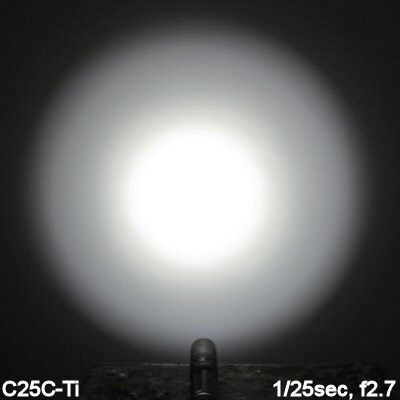
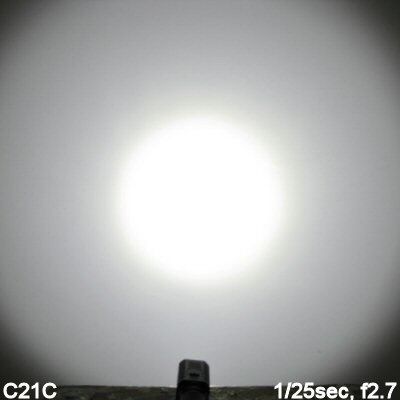
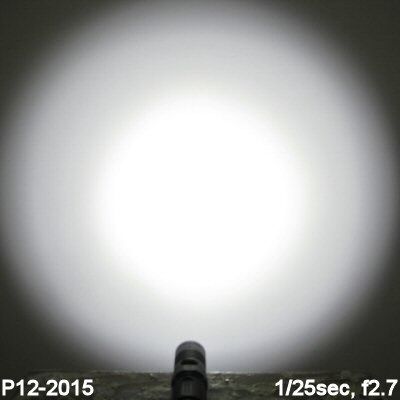
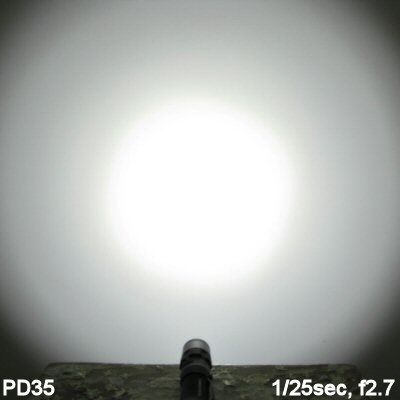
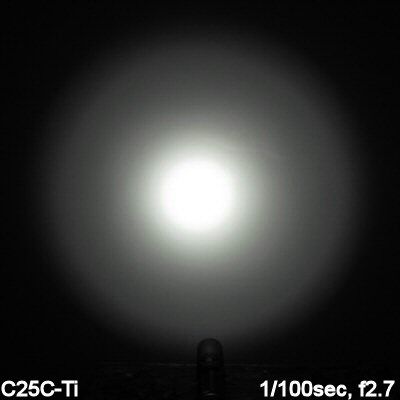
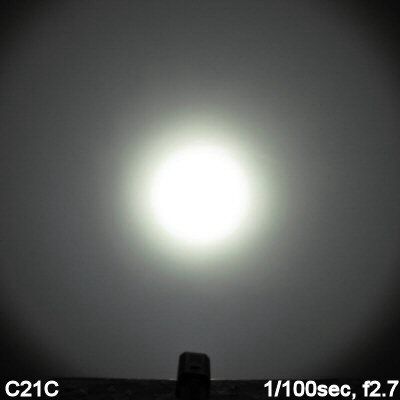

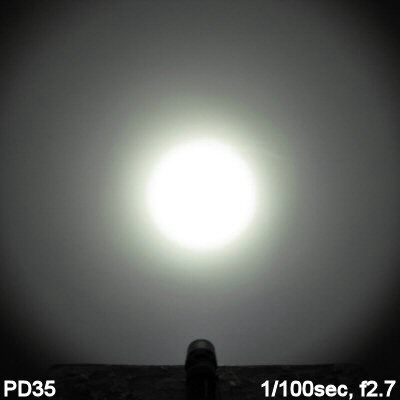
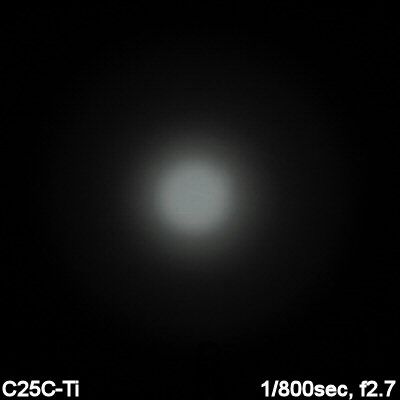
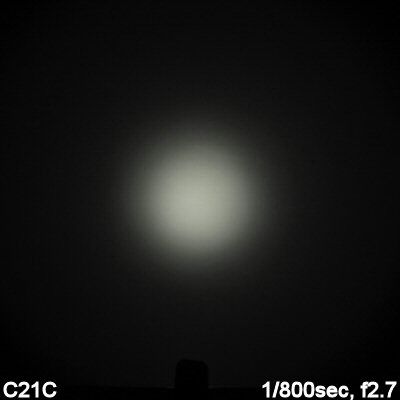
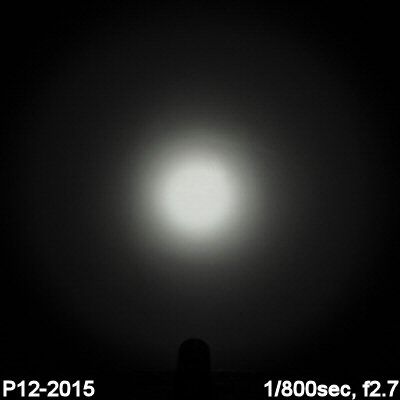
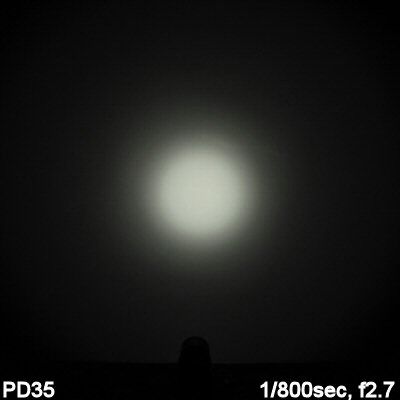
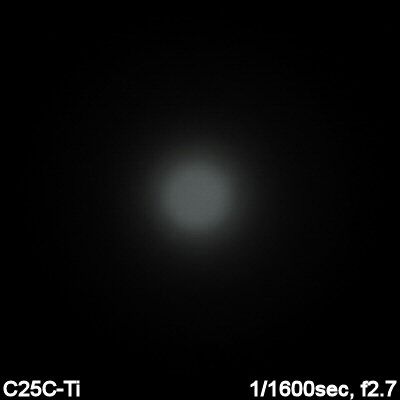
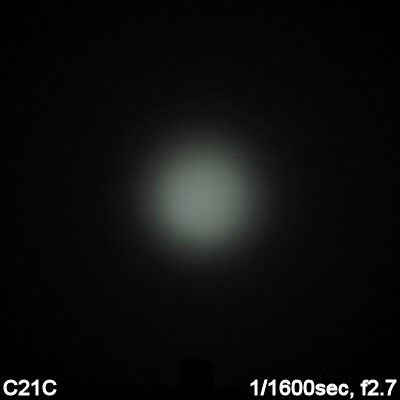
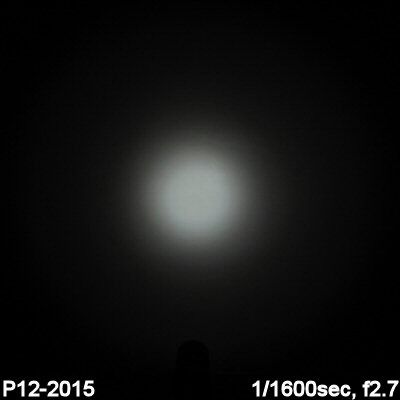
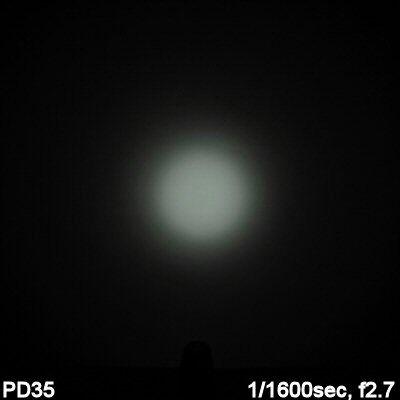
One main observation is that the C25C-Ti has a narrower spillbeam than typical - consistent with a narrow and deep reflector. While generally focused for throw, overall output is not as high as some of the competing lights in this class. Scroll down for detailed output and throw measures.
Testing Method:
All my output numbers are relative for my home-made light box setup, as described on my flashlightreviews.ca website. You can directly compare all my relative output values from different reviews - i.e. an output value of "10" in one graph is the same as "10" in another. All runtimes are done under a cooling fan, except for any extended run Lo/Min modes (i.e. >12 hours) which are done without cooling.
I have devised a method for converting my lightbox relative output values (ROV) to estimated Lumens. See my How to convert Selfbuilt's Lightbox values to Lumens thread for more info.
Throw/Output Summary Chart:
My summary tables are reported in a manner consistent with the ANSI FL-1 standard for flashlight testing. Please see http://www.flashlightreviews.ca/FL1.htm for a discussion, and a description of all the terms used in these tables. Effective July 2012, I have updated all my Peak Intensity/Beam Distance measures with a NIST-certified Extech EA31 lightmeter (orange highlights).
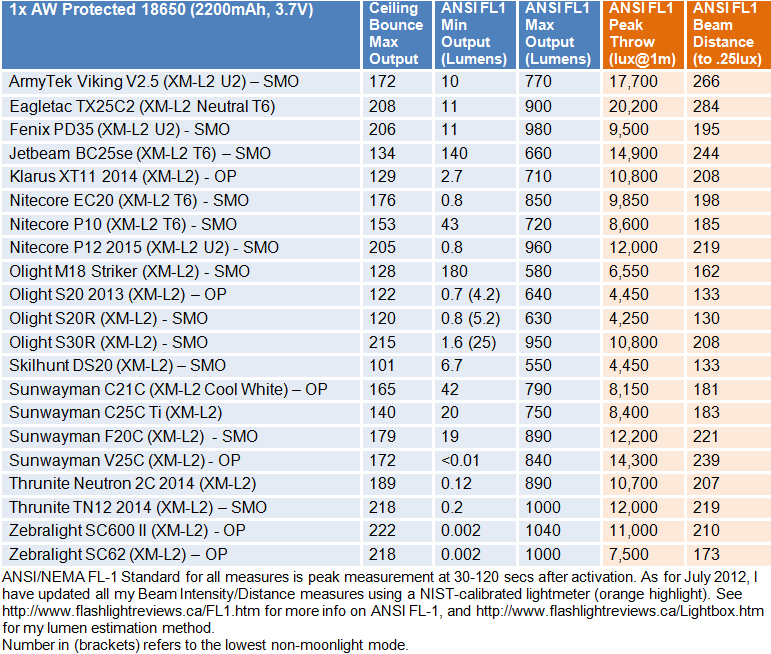
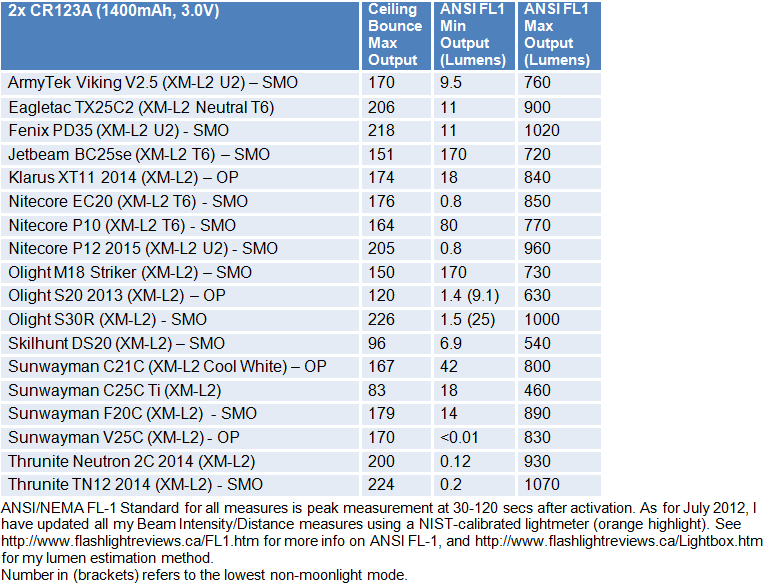
Max output is a little hard to characterize on this light, for reasons I will explain below. Let's start by looking at all the output levels, on both 1x18650 and 2xCR123A.
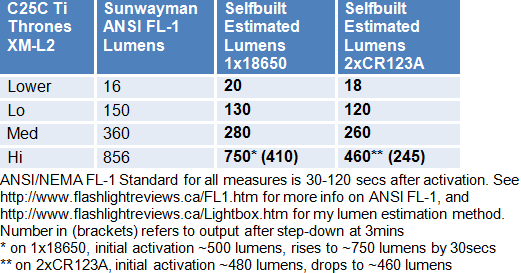
My ANSI FL-1 lumen estimates are close to the Sunwayman specs – although fairly consistently a bit below what is reported. But as I note in the footnote above, the initial output on max is a good amount lower, at ~500 lumens to start. Over the next 30 secs or so (on 18650), it rises to ~750 lumens, and then starts to slowly drop off. As such, the ANSI FL-1 rating above refers to the peak max output (since it falls within that time window). On the 2xCR123A, output is slightly lower across the board – and it barely changes on max.
What seems to be going on here is that when you switch to Hi, the circuit starts at an intermediate Med-Hi level, and then adjusts depending on the voltage source (i.e., stays Med-Hi for 2xCR123A, rises to the true Hi level on 1x18650). Can't say I've seen that before. :thinking: Let's check out the runtimes …
Output/Runtime Graphs:
All runtimes are done under a cooling fan. 18650 runtimes done using protected batteries based on the Panasonic NCR18650A core.
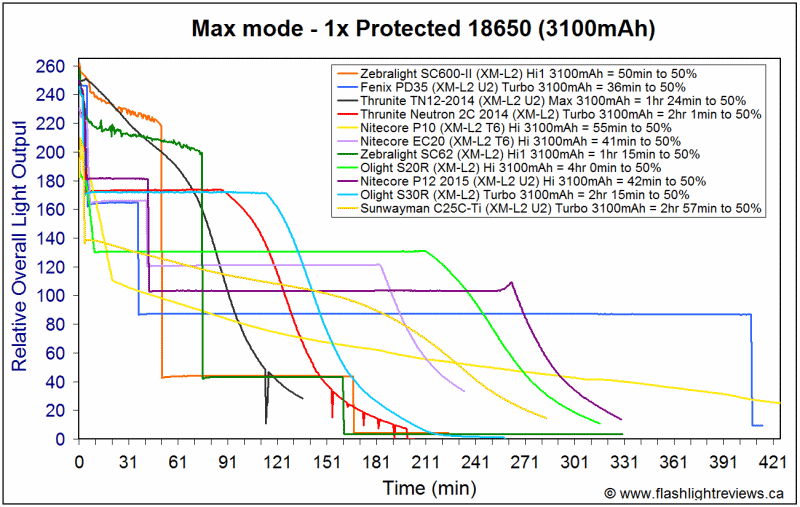
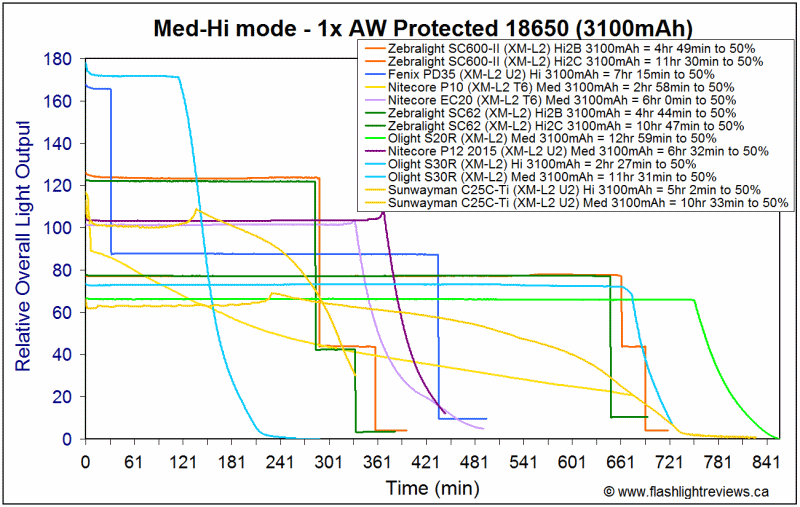
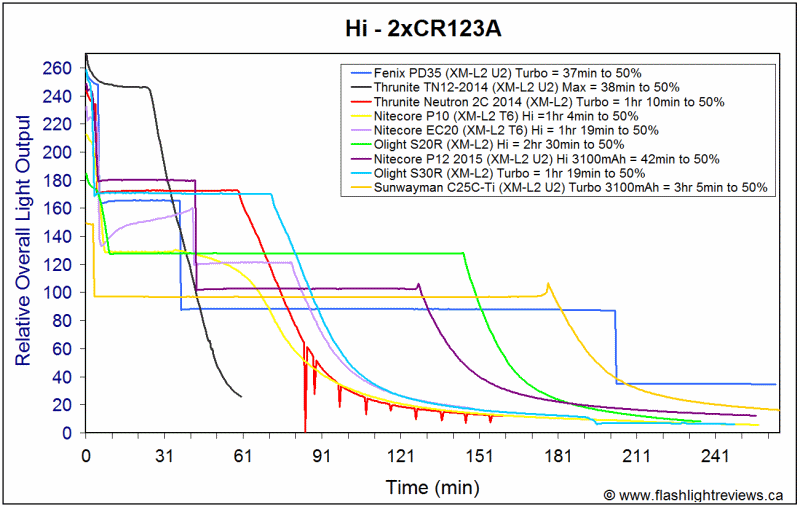
Overall efficiency of the C25C Ti is reasonable for a PWM-based light. Note that the current-controlled lights will always have an efficiency advantage. As such, the Nitecore P12 is a good example to compare to above.
The C25C Ti is not as flatly regulated as most of the competition, although this quite reasonable (i.e., you cannot see the slight changes over long periods of time).
Potential Issues
Unlike other Sunwayman offerings, the C25C-TI uses PWM on all modes (including Hi) at a visually detectable 964 Hz. I find the PWM not very noticeable on Hi on this light, but those sensitive to PWM will notice it on the lower modes (i.e., as perceptual visual "flicker").
Light uses an electronic switch in the tail, and therefore requires a stand-by current when fully connected - but this is completely negligible at ~11uA, and not a concern. There is an electronic lock-out feature if you are worried about accidental activation (although this is relatively unlikely due to the need for a sustained press turn on). Unfortunately, you cannot physically break the current on this light (i.e., there is no thread anodizing)
Max output is lower on 2xCR123A compared to 1x18650, at all levels. Note that max output is toward the lower end of this class, on all batteries.
Overall efficiency is not as high as the current-controlled competition, and regulation is typically not quite as flat-stabilized (but still quite reasonable). Please see my runtimes above for more info.
Titanium is a very solid material, but it is heavier than aluminum, and you should expect some "galling" with the screw threads (i.e., titanium on titanium is not as smooth as aluminum).
There is no anti-roll feature, and grip may be reduced from traditional lights in this class (but is good by all-titanium standards).
Preliminary Observations
The C25C-Ti is very distinctive, given the all-titanium construction and "medieval" styling. It is a very substantial light with good hand feel, and with some features normally only seen on high-end custom lights (e.g., tailcap trit, hidden indicator light, etc.). The C25C Ti is definitely not geared toward the entry-level or general purpose flashlight user – this light is for those looking for a little bling.
The electronic switch is fairly unique, and worked well in my testing. Certainly better than other lights with physical clickies and metal button covers (i.e., those tend to "stick" a lot). I really like the inclusion of the recessed trit and hidden battery read-out feature in the tail. oo:
oo:
That said, there are also some compromises here due to the all-titanium construction: there is galling on the screw threads, and no physical head lock-out feature. But this latter point is not a concern given the ridiculously low standby drain - and the switch and UI are designed to minimize the risk of accidental activation. :thumbsup:
Like the Nitecore P10 (which also uses a tailcap electronic switch), there is a visible pulse-width modulation (PWM) frequency of in <1 kHz range – on all levels, including max. I find this frequency a bit disappointing, as it means that PWM "flicker" is visually detectable. While it isn't that distracting in practice, it does detract from the light for me personally. :shrug:
As a result, outut/runtime performance of the C25C-Ti will be similar to other PWM-based lights in this class (e.g. Klarus XT11, Nitecore P10, etc.). So if maximum runtime and flat stabilization is important to you, you may want to consider other lights. But the overall performance of the C25C-Ti is definitely still acceptable for the class.
One unusual feature of the circuit is how the Hi mode starts off at a med-hi level (i.e., <500 lumens), and ramps up to final max over 30 secs or so – but only on 1x18650. It's subtle enough that you may not notice it happening, but you will likely notice that the light does seem brighter after a short delay. Not sure why it doesn't do this on 2xCR123A, but it may be to keep heat levels reasonable.
There is a quote from the first season of a certain TV show that may be relevant here: 'When you play the game of thrones, you win or you die.' Fortunately, the stakes for Sunwayman are not as high as they were for Ned Stark. Physically, the C25C-Ti is an eye-catching build. But the various circuit aspects outlined above may limit its general applicability for some. Put it this way - while this may not be the only light you would take along when going over the Wall with John Snow, it should certainly turn a few heads when out for a stroll with Sansa in King's Landing.
Physically, the C25C-Ti is an eye-catching build. But the various circuit aspects outlined above may limit its general applicability for some. Put it this way - while this may not be the only light you would take along when going over the Wall with John Snow, it should certainly turn a few heads when out for a stroll with Sansa in King's Landing. 
----
C25C-Ti provided by Sunwayman for review.



Sunwayman has released a titanium 1x18650 model, the C25C-Ti "Thrones". Judging from the font (and the imagery on their promotional material), I don't think it would be going out on limb to suggest that they are trying to link this to the popular Game of Thrones TV series and novels.
You don't see all-titanium lights in the 1x18650 class very often (likely due to the significant amount of titanium required). I think the last one I reviewed was the Bronte TU10-Ti.
The C25C Ti has some distinctive build elements … let's see how it compares to other lights in the 1x18650 class. :wave:
Manufacturer Reported Specifications:
(note: as always, these are simply what the manufacturer provides – scroll down to see my actual testing results).
- CREE XM-L2 U2 LED
- Output/Runtime: Turbo: 856 Lumens (Automatically lower to High mode after 3 mins continuous use), High: 360 Lumens (2.5hrs.), Mid: 150 Lumens (6hrs.), Low: 16 Lumens (80hrs.), Strobe: 856 Lumens
- Soft-contact Push-button Tail cap Switch
- Constant current circuit, constant output
- Low-voltage Indicator Lamp
- Effective range of 200 meters
- Uses 1x18650 battery or 2xCR123A batteries (batteries not included)
- Optimized deep metal reflector maintains great throw distance and spread with an ideal beam pattern
- Aerospace-grade titanium alloy body, blue tritium vial inserted at the tail cap
- Waterproof accords with IPX-8 standard
- Ultra-clear tempered glass lens resists scratches and impacts
- Tail stand capable- can be used as a candle
- Dimensions: 118mm (length) x 24mm (head diameter) x 24mm (tail diameter)
- Weight: 92.2g (battery excluded)
- Working voltage: 2.8~4.2V, Low-voltage indicator lamp at the tail cap, with the light turned-on, the indicator lamp will flicker once when voltage is 3V-3.4V; twice when voltage is 3.5-4V; three times when 4V-4.2V; five times when below 2.8-3V.
- standby current as low as 20μA
- Accessories: Lanyard, O-ring, Holster
- MSRP: ~$158


Packaging is a hard cardboard box with packing foam. As always, detailed specs and information are printed right on the box. Inside, included with the light are spare O-rings, wrist lanyard, holster with Velcro closing flap, product inserts, warranty card, and manual.



All dimensions directly measured, and given with no batteries installed:
Sunwayman C25C Ti Weight: 92.9g, Length: 120.2mm, Width (bezel): 25.3mm
Bronte TU10-Ti: Weight: 135.8g, Length: 140.6mm, Width (bezel): 30.6mm (32.2mm at widest base)
Eagletac D25LC2: Weight: 50.0g, Length: 116.3mm, Width (bezel): 22.5mm
Eagletac TX25C2: Weight 93.6g, Length: 120.4mm, Width (bezel): 31.6mm
Fenix PD35: Weight: 82.7g, Length: 138.1mm, Width (bezel): 25.4mm
Nitecore P12 2015: Weight: 88.7g, Length: 139.5mm, Width (bezel): 25.5mm
Nitecore P10: Weight 82.0g, Length: 135.1mm, Width (bezel): 25.5mm
Nitecore EC20: Weight: 77.1g, Length: 129.2mm, Width (bezel): 25.4mm
Thrunite TN12-2014: Weight: 80.0g, Length: 140.5mm, Width (bezel): 25.4mm
Skilhunt DS20: Weight: 53.8g, Length: 110.0mm, Width (bezel): 24.0mm
Zebralight SC600 II: Weight 79.3g, Length: 101.8mm, Width (bezel) 29.7mm
As you would expect for a titanium light, the C25C-Ti is heavier than most of the competition – but is still quite reasonable for the class.




The C25C-Ti is a distinctive light.
Weight has obviously increased over a comparably sized aluminum light, and the C25C-Ti has a substantial feel. There is good ridge detail all along the body and base of the head – nice and deep. This is something that is often limited on titanium lights. As a result, I would say overall grip is reasonable in this case (i.e., better than I was expecting, but not as high some lights). Unfortunately, the light can roll easily.
As always, I find fingerprints show up easily on the shiny titanium finish (but are easily wiped off). Labels are laser engraved, and fairly subtle and elegant.
There is a slightly raised contact point on the positive contact board in the head, so flat-top cells work fine. There is a spring at the base of the light.
The light uses standard triangular cut screw threads (and a good number of them). There is some galling on my sample (common to titanium lights), but it seems better here than on smaller titanium lights I've handled. There is no physical lock-out available – the light makes contact with the battery within the first turn of the threads.
The tail region is where things get interesting:


Unusually, the light uses an electronic switch in the tail. Not sure why they went with an electronic switch, but I have noticed that physical clickies with metal switch covers (especially on titantium lights), can be problematic for smooth and consistent operation. The switch here is recessed within a surrounding area, and has a very short traverse (consistent with electronic switches). There is a subtle click when fully pressing it. There are raised guards along the outside of the tail, where you can attach a wrist lanyard. The light can tailstand stably.
What really interesting here is the addition of the blue trit. While popular with a number of the custom makers/modders, this is the first time I can recall seeing one on a mainstream light from a major manufacturer.
As this sort of illumination requires no electrical energy, you will commonly find it in high-end wrist watches and emergency exit signs. And unlike the more common glow-in-the-dark phosphors you'll see on cheap watches (and o-rings, boot switch covers, etc), you don't need to pre-charge with visible light first – the tritium is a regular source of electrons (well, for a while anyway – its half-life is a little over a decade).
As with most trits, the fluorescent light emitted isn't very bright – but it doesn't need to be. For dark-adapted eyes, it's a very comfortable level of light to help you find the switch in the dark. :thumbsup:
Another interesting feature is the battery read-out indicator upon activation, which is a red light around the switch button.

For the shot above, I turned the light on while head-standing the flashlight in the dark. As you can see, the indicator glows red when you first activate the light (you can faintly see the blue trit in the middle of the pic above). With a fully charged cell, the red indicator flashed 3 times. According to the instructions online, it will flash once when voltage is between ~3V-3.4V, twice when ~3.5-4V, and three times when ~4V-4.2V. Oddly, it is supposed to flash five times when below 3V.
Let's look at the head:


The C25C-Ti comes with a flat titanium bezel. Reflector is smooth, and surprisingly deep given this size head. Coupled with the XM-L2 cool white emitter (which was well centered on my sample), I would expect a fairly narrow spillbeam, with above average throw for a light this size. Scroll down for beamshots.
User Interface
The user interface is straight-forward. Turn the light on/off by a press-hold of the switch (>1 sec)
Change modes my clicking the switch (rapid press-release). Mode sequence is Lo > Med > Hi > Turbo, in repeating sequence. The light has mode memory, and retains the last level set if you turn off/on.
There a "hidden" strobe mode, accessed by a double-click of the switch when on. A single click returns you to the memorized constant-on mode.
There is a lockout mode from off – double click the switch, but hold on the second click (i.e. a rapid click and press hold). This will prevent accidental activation. Repeat the sequence to unlock the light.
Video:
For more information on the overall build and user interface, please see my video overview:
As with all my videos, I recommend you have annotations turned on. I commonly update the commentary with additional information or clarifications before publicly releasing the video.
As an aside, if you want to get an instant notification for every new review that I post here on CPF, you can subscribe to my YouTube channel (the vids go public at the same time). Just mouse over my logo watermark on the top right-hand corner of the video for the subscribe feature to open up. You may need to tap or click, depending on the platform you are using to watch. :wave:
PWM/Strobe
The C25C-Ti uses pulse width modulation (PWM) at all levels.
Lo:

Med:

Hi:

Turbo:

This is a classic PWM pattern, with an increasing pulse duration as you go up in output level, all with a common 964 Hz frequency. What is a little unusual is its continued presence on Turbo. I suspect this latter point reflects how the electronic tail switch interacts with the circuit in the head (and how it responds to different battery voltages). See runtimes later in this review for additional commentary.
In any case, I find this 964 Hz frequency noticeable in use, especially at the lower levels. You will want to keep this in mind if you are particularly sensitive to PWM flicker.
There is also a secondary signal noise pattern, noticeable at longer time scales on my oscilloscope. Here is an example on the Lo level:

This doesn't produce any visible effect, however.
Strobe

The strobe is a fast "tactical" strobe, at 10.5 Hz frequency. You can see the effect of the secondary circuit noise in the oscilloscope trace above – again, this is not visually detectable.
Standby Drain
Since the C25C-Ti uses an electronic switch, there needs to be a standby current when the tailcap is connected. I measure this as a negligible ~11 uA on my sample. For a 3100mAh 18650, would mean it would take over three decades to fully drain the cell (i.e., beyond the standard discharge rate of Li-ions).
The risk of accidental activation is low, due to the sustained press required to turn on (and raised surround). But the light can be locked out electronically (see UI section above), if you are concerned. Unfortunately a physical lock-out is not available.
Beamshots:
For white-wall beamshots below, all lights are on Max output on a protected 18650 battery. Lights are about ~0.75 meter from a white wall (with the camera ~1.25 meters back from the wall). Automatic white balance on the camera, to minimize tint differences.
















One main observation is that the C25C-Ti has a narrower spillbeam than typical - consistent with a narrow and deep reflector. While generally focused for throw, overall output is not as high as some of the competing lights in this class. Scroll down for detailed output and throw measures.
Testing Method:
All my output numbers are relative for my home-made light box setup, as described on my flashlightreviews.ca website. You can directly compare all my relative output values from different reviews - i.e. an output value of "10" in one graph is the same as "10" in another. All runtimes are done under a cooling fan, except for any extended run Lo/Min modes (i.e. >12 hours) which are done without cooling.
I have devised a method for converting my lightbox relative output values (ROV) to estimated Lumens. See my How to convert Selfbuilt's Lightbox values to Lumens thread for more info.
Throw/Output Summary Chart:
My summary tables are reported in a manner consistent with the ANSI FL-1 standard for flashlight testing. Please see http://www.flashlightreviews.ca/FL1.htm for a discussion, and a description of all the terms used in these tables. Effective July 2012, I have updated all my Peak Intensity/Beam Distance measures with a NIST-certified Extech EA31 lightmeter (orange highlights).


Max output is a little hard to characterize on this light, for reasons I will explain below. Let's start by looking at all the output levels, on both 1x18650 and 2xCR123A.

My ANSI FL-1 lumen estimates are close to the Sunwayman specs – although fairly consistently a bit below what is reported. But as I note in the footnote above, the initial output on max is a good amount lower, at ~500 lumens to start. Over the next 30 secs or so (on 18650), it rises to ~750 lumens, and then starts to slowly drop off. As such, the ANSI FL-1 rating above refers to the peak max output (since it falls within that time window). On the 2xCR123A, output is slightly lower across the board – and it barely changes on max.
What seems to be going on here is that when you switch to Hi, the circuit starts at an intermediate Med-Hi level, and then adjusts depending on the voltage source (i.e., stays Med-Hi for 2xCR123A, rises to the true Hi level on 1x18650). Can't say I've seen that before. :thinking: Let's check out the runtimes …
Output/Runtime Graphs:
All runtimes are done under a cooling fan. 18650 runtimes done using protected batteries based on the Panasonic NCR18650A core.



Overall efficiency of the C25C Ti is reasonable for a PWM-based light. Note that the current-controlled lights will always have an efficiency advantage. As such, the Nitecore P12 is a good example to compare to above.
The C25C Ti is not as flatly regulated as most of the competition, although this quite reasonable (i.e., you cannot see the slight changes over long periods of time).
Potential Issues
Unlike other Sunwayman offerings, the C25C-TI uses PWM on all modes (including Hi) at a visually detectable 964 Hz. I find the PWM not very noticeable on Hi on this light, but those sensitive to PWM will notice it on the lower modes (i.e., as perceptual visual "flicker").
Light uses an electronic switch in the tail, and therefore requires a stand-by current when fully connected - but this is completely negligible at ~11uA, and not a concern. There is an electronic lock-out feature if you are worried about accidental activation (although this is relatively unlikely due to the need for a sustained press turn on). Unfortunately, you cannot physically break the current on this light (i.e., there is no thread anodizing)
Max output is lower on 2xCR123A compared to 1x18650, at all levels. Note that max output is toward the lower end of this class, on all batteries.
Overall efficiency is not as high as the current-controlled competition, and regulation is typically not quite as flat-stabilized (but still quite reasonable). Please see my runtimes above for more info.
Titanium is a very solid material, but it is heavier than aluminum, and you should expect some "galling" with the screw threads (i.e., titanium on titanium is not as smooth as aluminum).
There is no anti-roll feature, and grip may be reduced from traditional lights in this class (but is good by all-titanium standards).
Preliminary Observations
The C25C-Ti is very distinctive, given the all-titanium construction and "medieval" styling. It is a very substantial light with good hand feel, and with some features normally only seen on high-end custom lights (e.g., tailcap trit, hidden indicator light, etc.). The C25C Ti is definitely not geared toward the entry-level or general purpose flashlight user – this light is for those looking for a little bling.
The electronic switch is fairly unique, and worked well in my testing. Certainly better than other lights with physical clickies and metal button covers (i.e., those tend to "stick" a lot). I really like the inclusion of the recessed trit and hidden battery read-out feature in the tail.
That said, there are also some compromises here due to the all-titanium construction: there is galling on the screw threads, and no physical head lock-out feature. But this latter point is not a concern given the ridiculously low standby drain - and the switch and UI are designed to minimize the risk of accidental activation. :thumbsup:
Like the Nitecore P10 (which also uses a tailcap electronic switch), there is a visible pulse-width modulation (PWM) frequency of in <1 kHz range – on all levels, including max. I find this frequency a bit disappointing, as it means that PWM "flicker" is visually detectable. While it isn't that distracting in practice, it does detract from the light for me personally. :shrug:
As a result, outut/runtime performance of the C25C-Ti will be similar to other PWM-based lights in this class (e.g. Klarus XT11, Nitecore P10, etc.). So if maximum runtime and flat stabilization is important to you, you may want to consider other lights. But the overall performance of the C25C-Ti is definitely still acceptable for the class.
One unusual feature of the circuit is how the Hi mode starts off at a med-hi level (i.e., <500 lumens), and ramps up to final max over 30 secs or so – but only on 1x18650. It's subtle enough that you may not notice it happening, but you will likely notice that the light does seem brighter after a short delay. Not sure why it doesn't do this on 2xCR123A, but it may be to keep heat levels reasonable.
There is a quote from the first season of a certain TV show that may be relevant here: 'When you play the game of thrones, you win or you die.' Fortunately, the stakes for Sunwayman are not as high as they were for Ned Stark.

----
C25C-Ti provided by Sunwayman for review.
Last edited:

